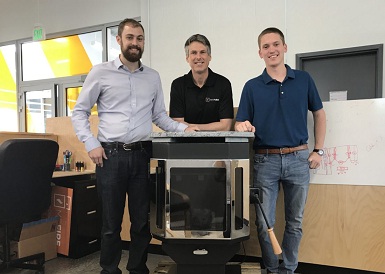
US DOE awards $3M for R&D to wood stove manufacturers
October 4, 2019
By Alliance for Green Heat
 The MF Fire leadership team in 2018
- Taylor Myers, Paul LaPorte and
Ryan Fisher. Photo source: www.forgreenheat.org.
The MF Fire leadership team in 2018
- Taylor Myers, Paul LaPorte and
Ryan Fisher. Photo source: www.forgreenheat.org. The U.S. Department of Energy (DOE) selected two companies – MF Fire and ISB Marketing – to receive USD$3 million for research and development (R&D) on smart, automated wood stoves through the DOE’s Office of Energy Efficiency and Renewable Energy. The DOE had $5 million for stove and boiler manufacturers but decided to only award $3 million this year for wood and pellet heaters.
Approximately 12 million homes have wood or pellet stoves and about 2.3 million of them are used as a primary or sole heating source. This makes the ordinary wood stove the most common renewable energy device in American homes, far outnumbering solar panels and geothermal systems combined. But this marks the first time that the DOE has sought to modernize a device that many still associate with Ben Franklin, considered the grandfather of American stove technology.
Many dismiss the wood stove as old-fashioned technology that emits too much smoke, yet Americans still buy and install 150,000 to 250,000 of them every year. The two manufacturers receiving grants are run by a younger generation of stove makers that have a high-tech vision for wood stoves that can be part of the modern renewable energy movement.
MF Fire received two grants, one for a device that continuously monitors performance of key combustion indicators and delivers real-time user guidance and the other for a “swirl stove” that induces and maintains swirling combustion and introduces a new balance of primary, secondary, and dilutive air. ISB Marketing, working with its sister company, Stove Builder International (SBI), is developing a Machine Learning algorithm for a self-regulating wood stove that would have a ultra-low emissions and high efficiency.
DOE is expected to be able to offer R&D grant funding again in 2020 and may be able to stimulate R&D in more wood heater manufacturers. “We applaud Congressional appropriators and the DOE for funding this R&D that can help millions of Americans affordably heat their homes with renewable energy, a great complement to solar panels which provide electricity but usually can’t provide enough for heating,” said John Ackerly, president of the Alliance for Green Heat.
The $2 million for MF Fire “will enable us apply techniques and technologies commonly used by other industries,” said Ryan Fisher, COO of Baltimore based MF Fire. “For example, eliminating PM by more thoroughly and aggressively mixing fuel and air has not been done by stove manufacturers. Square, rectangular corners create dead spots that inhibit combustion.” Mr. Fisher said. Fisher and his original partner Taylor Myers got their start in designing stoves as graduate students preparing for the first Wood Stove Design Challenge in 2013. The rookies won multiple awards before the age of 25 and still haven’t turned 30. Some see them as the face of a new wave of stove designers.
ISB Marketing, with their SBI counterparts, are taking a similar tack and have a large manufacturing and distributing network behind them. ISB is working with Machine Learning algorithm that will learn how each specific user heats his/her stove. The stove will then adjust its combustion parameters to compensate for any “bad” human behaviour that tends to increase particulate matter (PM) emissions and reduce efficiency. A home-designed real-time PM monitoring system will be developed to obtain a better understanding of the stove’s behaviour.
Marc-Antoine Cantin, president of SBI said in an interview that moving innovative and more risky stove projects takes longer, as models that have conventional technology are often green-lighted first. “External R&D funding can help reduce risk,” Cantin said. SBI won second place at the 2018 Wood Stove Design Challenge.
The DOE does not disclose how many applications they received or from whom, but it is widely believed that the agency received few applications for the available $5 million pot of funding.
This recent entry of the DOE’s Bioenergy Technologies Department which focuses mainly on biofuels, fills a significant gap for the U.S. government. The EPA provides baseline emission and testing standards and the USDA’s Forest Service provides support for larger commercial use of biomass for heating applications. This marks the first time that a US government agency has provided support for companies to push the boundaries of emission and efficiency controls for residential wood and pellet heaters. The United States has the toughest emission standards for residential heaters in the world, which has kept U.S. companies at the forefront of an industry that can provide affordable, low carbon heating solutions in the switch from fossil fuels to renewables.
Print this page